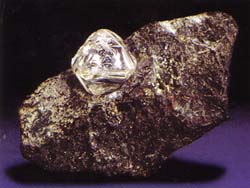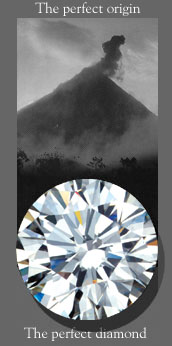 DIAMONDS ARE BORN, NOT MADE.
DIAMONDS ARE BORN, NOT MADE.
Mystery surrounds the formation and location of these brilliant survivors of creation. Formed from crystallized carbon in the depths of the earth billions of years ago, diamonds are brought to the surface in fiery flows of magma.
As the volcanoes cool, diamonds are hidden in a black rock called kimberlite and only reluctantly part from it under great duress. Thousands of tons of rock are crushed and sorted to liberate one single carat of diamond.
Born in heat and pressure, raised in fire and locked in rock, diamonds truly come to life only in the hands of man. Some of the best of these highly skilled artisans create the RAND Diamond.
EARLY DISCOVERIES
In India around the 7th century B.C., diamonds exceptional hardness and beauty had been recognized and raised to symbolic and legendary proportions. In fact, one of the earliest mentions of diamonds occurs in the biblical Book of Exodus around 1200 BC. The word diamond itself is derived from the Latin diamas, from Greek root adamas, meaning indestructible. Diamonds spread across Europe and the Middle East where Arab traders had used the carob bean as the unit of measure of centuries. The size and uniformity of the carob made in an excellent choice for the weighing of diamonds and history lives on with the term carat today.
Even as we value diamonds today in fine jewelry and engagement rings, this practice had its first known use in 1477 when the Archduke Maximillian of Austria presented Mary of Burgundy an engagement ring mounted with a fine diamond. The fact that they were married the next day was an encouraging sign for the jewelers everywhere. Mary wore the ring on her left hand believing that the love vein ran directly to the heart, a practice followed to this day. The diamond business as we know it actually started in 1870 with the discovery of major rough diamond deposits in the Cape area of South Africa. An itinerant shepherd discovered an 83.5 carat rough which was promptly named Star of South Africa. The stone was sold to the Earl of Dudley in London for the princely sum of 30,000 pounds Sterling, an enormous sum in those days. News of the size and quality of the rough found in those early diggings reached the world and the rush was on! A bitter and ruthless struggle for control of the mines between Barney Barnato and Cecil Rhodes ensued and it was to shape both an industry and a continent forever. Over the next three decades discoveries of extraordinarily large rough like the 971ct Excelsior and the 634ct Jubilee would lead to a series of diamond rushes that spread further and further out into the surrounding farm land. One of these farms was owned the De Beers brothers who had purchased it from South African government ten years earlier for $250.
Three generations of the one family have personality taken responsibility for the quality of their diamonds. Since patriarch Barney Laub founded the RAND Diamond Group on the diamond fields of South Africa more than fifty years ago, it has been a Diamond Trading Corporation sight holder, one of a small number selected to acquire rough diamonds directly.
Since 1947 when we began operating the wholly owned RAND Diamond Cutting Works in Johannesburg, South Africa, the family continues to dedicate themselves to quality and value in their diamonds. In 2006 RAND opened its cutting works in Botswana, bringing direct economic opportunity to the people of that Democratic country. To this day RAND continues to exercise complete control of each RAND Diamond, from the supply to you..
All fine diamonds can have a GIA diamond grading report. Only the RAND Diamond comes with its own Provenance Report, unique in the entire industry. Think of it as the birth certificate for your customer's diamond. From the moment rough diamonds arrive is individually numbered, registered and photographed.

